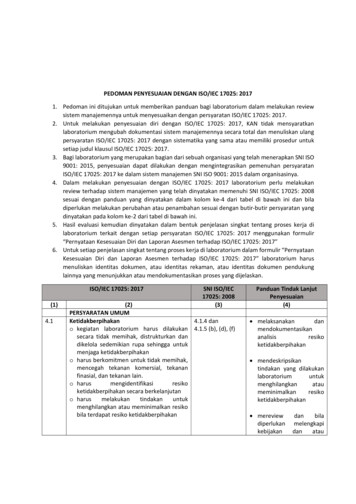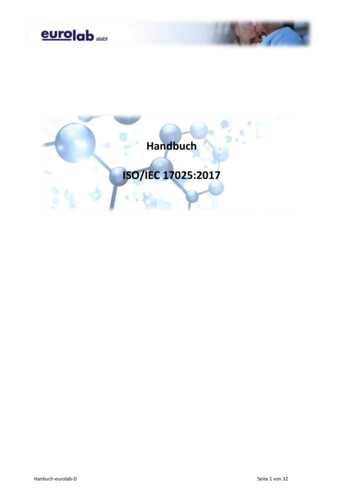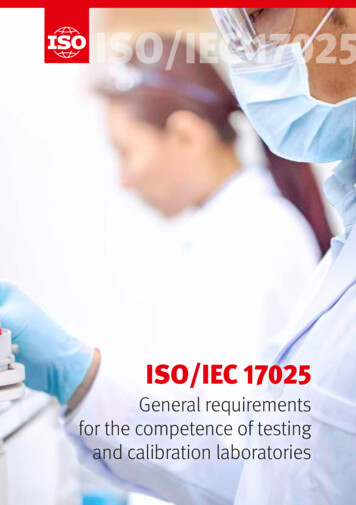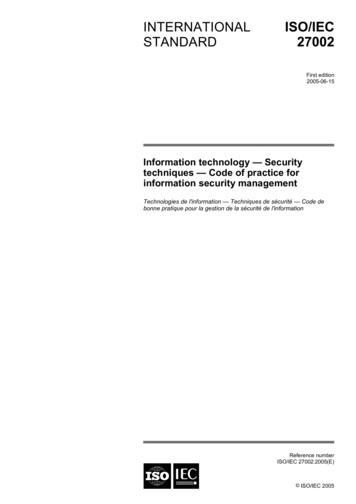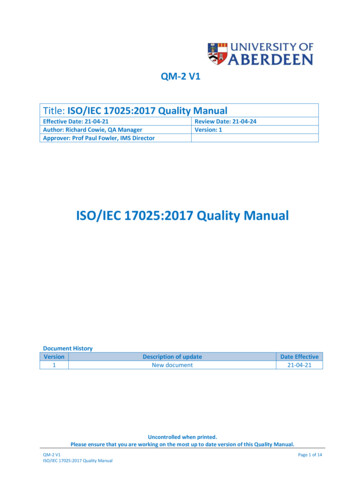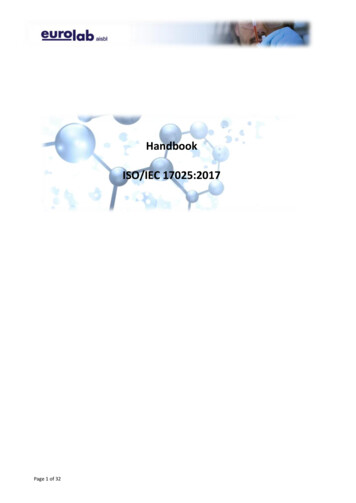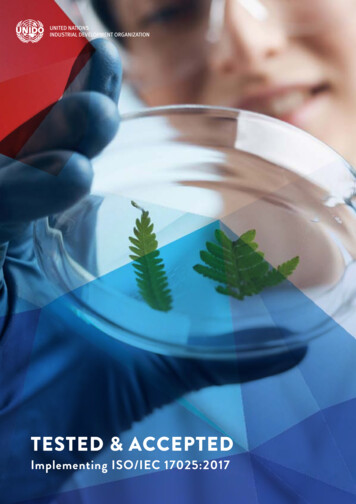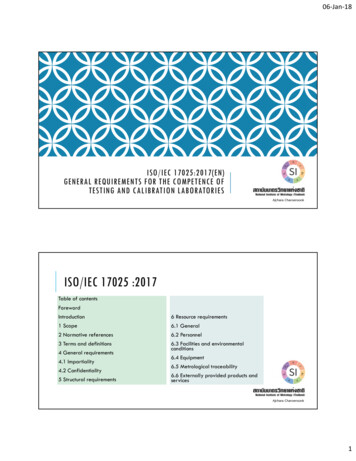
Transcription
06‐Jan‐18ISO/IEC 17025:2017(EN)GENERAL REQUIREMENTS FOR THE COMPETENCE OFTESTING AND CALIBRATION LABORATORIESAjchara CharoensookISO/IEC 17025 :2017Table of contentsForewordIntroduction6 Resource requirements1 Scope6.1 General2 Normative references6.2 Personnel3 Terms and definitions6.3 Facilities and environmentalconditions4 General requirements4.1 Impartiality4.2 Confidentiality5 Structural requirements6.4 Equipment6.5 Metrological traceability6.6 Externally provided products andservicesAjchara Charoensook1
06‐Jan‐18ISO/IEC 17025 :20177 Processrequirements8 Management system requirements7.1 Review of requests, tenders and contracts8.1 Options7.2 Selection, verification and validation of methods8.2 Management system documentation (Option A)7.3 Sampling8.3 Control of management system documents (Option A)7.4 Handling of test or calibration items8.4 Control of records (Option A)7.5 Technical records7.6 Evaluation of measurement uncertainty7.7 Ensuring the validity of results7.8 Reporting of results7.9 Complaints7.10 Nonconforming work7.11 Control of data and information management8.5 Actions to address risks and opportunities (Option A)8.6 Improvement (Option A)8.7 Corrective actions (Option A)8.8 Internal audits (Option A)8.9 Management reviews (Option A)Annex A Metrological traceabilityAnnex B Management system optionsBibliographyAjchara CharoensookISO/IEC 17025 :2017The main changes— the risk-based thinking applied in this edition has enabledsome reduction in prescriptive requirements and their replacementby performance-based requirements;— there is greater flexibility than in the previous edition inthe requirements for processes, procedures, documented informationand organizational responsibilities;— a definition of “laboratory” has been added in definition.Ajchara Charoensook2
06‐Jan‐18ISO/IEC 17025 :2017In this document, the following verbal forms are used:— “shall” indicates a requirement;— “should” indicates a recommendation;— “may” indicates a permission;— “can” indicates a possibility or a capability.Ajchara CharoensookWHAT IS RISK-BASED THINKING?The concept of risk has always been implicit in ISO 9001 –the 2015 revisionmakes it more explicit and builds it into the whole management systemRisk-based thinking is already part of the process approach.Risk-based thinking makes preventive action part of the routine.Risk is often thought of only in the negative sense .Risk-based thinking can also help to identify opportunities. This can beconsidered to be the positive side of risk.Ajchara Charoensook3
06‐Jan‐181. SCOPEThis document specifies the general requirements for the competence,impartiality and consistent operation of laboratories.This document is applicable to all organizations performing laboratoryactivities, regardless of the number of personnel.Laboratory customers, regulatory authorities, organizations and schemes usingpeer-assessment, accreditation bodies, and others use this document inconfirming or recognizing the competence of laboratories.Ajchara Charoensook2 NORMATIVE REFERENCESThe following documents are referred to in the text in such a way that some orall of their content constitutes requirements of this document. For datedreferences, only the edition cited applies. For undated references, the latestedition of the referenced document (including any amendments) applies.ISO/IEC Guide 99, International vocabulary of metrology — Basic and generalconcepts and associated terms (VIM)1ISO/IEC 17000, Conformity assessment — Vocabulary and general principlesAjchara Charoensook4
06‐Jan‐183 TERMS AND DEFINITIONSFor the purposes of this document, the terms and definitions givenin ISO/IEC Guide 99 and ISO/IEC 17000 and the following apply.ISO and IEC maintain terminological databases for use in standardization atthe following addresses:— ISO Online browsing platform: availableat https://www.iso.org/obp— IEC Electropedia: availableat http://www.electropedia.org/Ajchara Charoensook3 TERMS AND DEFINITIONS3.1 impartialitypresence of objectivityNote 1 Objectivity means that conflicts ofinterest do not exist, or are resolved so as not toadversely influence subsequent activities of the laboratory (3.6).Note 2 Other terms that are useful in conveying the elementof impartiality include “freedom from conflict of interests”,“freedom from bias”, “lack of prejudice”, “neutrality”,“fairness”, “open-mindedness”, “even-handedness”,“detachment”, “balance”.Ajchara Charoensook5
06‐Jan‐183 TERMS AND DEFINITIONS3.2 complaintexpression of dissatisfaction by any person or organization to a laboratory (3.6),relating to the activities or results of that laboratory, where a response is expected3.3 interlaboratory comparisonorganization, performance and evaluation of measurements or tests on the same orsimilar items by two or more laboratories in accordance with predetermined conditions3.4 intralaboratory comparisonorganization, performance and evaluation of measurements or tests on the same orsimilar items within the same laboratory (3.6) in accordance with predeterminedconditionsAjchara Charoensook3 TERMS AND DEFINITIONS3.5 Proficiency testingEvaluation of participants performance against pre-establishedcriteria by means of interlabolatory comparison.3.6 LaboratoryBody that performs one or more of the following activities;- testing- calibration- sampling associated with subsequent testing or calibrationAjchara Charoensook6
06‐Jan‐183 TERMS AND DEFINITIONS3.7 decision rulerule that describes how measurement uncertainty is accounted for whenstating conformity with a specified requirement3.8 verificationprovision of objective evidence that a given item fulfils specifiedrequirements3.9 validationverification (3.8 ), where the specified requirements are adequate for anintended useAjchara CharoensookRISK MANAGEMENTRequires the laboratory to plan and implement actionsto address risks and opportunities.Establishes a basis for increasing the effectiveness of thequality management system, achieving improved resultsand preventing negative effects.The laboratory is responsible for deciding which risksand opportunities need to be addressedAjchara Charoensook7
06‐Jan‐18WHAT SHOULD WE DO ?1. Identify what the risks and opportunities are in yourorganization2. Plan actions to address the risks- how can I avoid or eliminate the risk?- how can I mitigate the risk ?3. Implement the plan – take action4. Check the effectiveness of the actions – does it work?Ajchara CharoensookIMPARTIALITY (4.1)In order to safeguard impartiality- Establish structure- Mitigate pressures Identify & manage risks (ongoing basis)Risks may come from .- its activities- its relationship- the relationship of its personnel Demonstrate how to minimize or eliminate RisksAjchara Charoensook8
06‐Jan‐18CONFIDENTIALITY (4.2)Legally enforceable commitment for management of informationobtained or created during the performance of laboratoryactivities. Inform customer of if public exposure of information Third party communication requirementAjchara CharoensookSTRUCTURAL REQUIREMENTS (5)Legal entityIdentify managementDefine and document thelaboratory activitiesMeet the requirements of ISO/IEC 17025 :2017 Customers Regulatory authorities andorganizations providing recognitionsLaboratory activities can be ; Permanent facilities At sites away from its permanentfacilities Temporary Mobile facilities Customer’s facility.Ajchara Charoensook9
06‐Jan‐18STRUCTURAL REQUIREMENTS (5) Define organization and managementstructure and relationships betweenmanagement , technical operations andsupport services; Specify responsibility ,authority andinterrelationship of all personnel whomanage , perform or verify works; Document its procedures to ensureconsistency of works and validity of theresults. Have personnel with authority andresources needed to carry out laboratoryactivities including: implementation,maintenance,improvement, identification ofdeviations , initiation of actions to prevent orminimize deviations ,reporting tomanagement on the performance ofmanagement system .Ajchara CharoensookSTRUCTURAL REQUIREMENTS (5)Ensuring the effectiveness of laboratory activities. Communication take place regarding the effective of the managementsystem and the importance of meeting customers and other requirements; Integrity of management system is maintained when changed to themanagement system are planned and implemented.Ajchara Charoensook10
06‐Jan‐18RESOURCE REQUIREMENTS (6)Availability of personnel, facilities, equipment, systems and support services. (6.1)Personnel (6.2) Act impartially, be competent and work in accordance with lab’s managementsystem Evidences of the competence requirements (education, qualification, training,technical knowledge ,skills and experience) Competence to perform laboratory activities and to evaluate the significance ofdeviations Communicate to personnel their duties, responsibilities and authorities.Ajchara CharoensookFACILITIES AND ENVIRONMENTAL CONDITIONS ( 6.3) Suitable for laboratory activities and not adversely affect the validityof results Documented requirements for facilities and environmental conditions Monitor, control and record environmental conditions Measures to control facilities including: Access to and use of areas affecting laboratory activities; Prevention of contamination, interference or adverse influences on laboratory activities; Effective separation between areas with incompatible laboratory activities. Ensure that environmental conditions are met when performing outsideits permanent controlAjchara Charoensook11
06‐Jan‐18EQUIPMENT (6.4) Available and function properly Action for out of service Conform with specification before placeinto service Intermediate checks Capable to achieve required accuracy Calibration of measuring equipment Establish calibration program Calibration status Update/implement correction factors orreference values Measures to prevent unintendedadjustment Equipement recordsAjchara CharoensookMETROLOGICAL TRACEABILITY (6.5) Establish and maintain metrological traceability of its measurement results Ensure that measurement results are traceable to the SI units: Competent laboratory; Competent producer; Comparison, directly or indirectly with national or international standards. Demonstrate metrological traceability to an appropriate reference when nottechnical possible to the SI units: Competent producer; Suitable comparison.Ajchara Charoensook12
06‐Jan‐18EXTERNALLY PROVIDED PRODUCTS AND SERVICES (6.6)Ensure that suitable externally provided products andservices are used when products and services: Are intended for incorporation into the laboratory’s own activities; Are provided ,in part or in full, directly to the customer by thelaboratory as received from the external provider; Are used to support the operation of the laboratory.Ajchara CharoensookPROCESS REQUIREMENTS (7)Ajchara Charoensook13
06‐Jan‐18REVIEW OF REQUESTS,TENDERS AND CONTRACTS (7.1) Have a procedure for the review Inform customer when methodrequested by the customer is notappropriate or out of date Clearly defined a statement ofconformity when requested by thecustomer Resolve any difference between therequest or tender and the contractbefore commencing work Inform customer if any deviationfrom the contract Repeat contract review if amendedafter work and communicate to allaffected personnel Cooperate with customers or theirrepresentatives in clarifying thecustomer’s request and in monitoringthe laboratory’s performance inrelation to the work performed Retain records of reviewsAjchara CharoensookSELECTION, VERIFICATION AND VALIDATION OF METHODS (7.2) Use appropriate methods andprocedures for all laboratory activities Up to date methods, procedures andsupporting documents are kept andmade readily available to personnel Uses the latest version unless notpossible to do Select appropriate method whencustomer does not specify Verify methods before introducingthem to ensure it can achieve therequired performance. Have Action plan for methoddevelopment Document, technically justify,authorize and accept by the customerif any deviation from methods Validate non –standard methods ,laboratory developed methods andstandard methods usedoutside their intended scope ormodify Retain records of validationAjchara Charoensook14
06‐Jan‐18SAMPLING (7.3) Samplingplan Sampling method Retain recordsAjchara CharoensookHANDLING OF TEST OR CALIBRATION ITEMS (7.4) Havea procedure Have a system for unambiguous identification Records of the item Facilities to maintain itemsAjchara Charoensook15
06‐Jan‐18TECHNICAL RECORDS (7.5) Sufficientinformation Amendment can be tracked to previous versions ororiginal observationsAjchara CharoensookEVALUATION OF MEASUREMENT UNCERTAINTY(7.6) Identify the contributions to measurement uncertainty Evaluate for all calibrations (calibration lab) Evaluate measurement uncertainty where test method precludesrigorous evaluation of measurement uncertaintyAjchara Charoensook16
06‐Jan‐18ENSURING THE VALIDITY OF RESULTS (7.7) Havea procedure for monitoring the validity of results Monitor its performance by comparison with results of otherlaboratories Analyze and use data from monitoring to control and improvethe laboratory’s activities Take action when data from the monitoring are found to be outsidepre-defined criteriaAjchara CharoensookREPORTING THE RESULTS (7.8) General– review and authorize prior to release Common requirements for reports Specific requirements for test reports Specific requirements for calibration certificates Specific requirements for reporting sampling Reporting statements of conformity Reporting opinions and interpretations Amendments to reportsAjchara Charoensook17
06‐Jan‐18COMPLAINTS (7.9) Have a documented process to receive ,evaluate and make decision on complaints Responsible for all decisions at all levels ofhandling process of complaints and madeavailability of description of handlingprocess for complaints to interested party Include at least the following elements andmethod: Description of the process Tracking and recording complaints Ensuring that appropriate action is taken Responsible for gathering andverifying all information to validate thecomplaint Acknowledge receipt of the complaint,and provide the complainant withprogress report and outcome Review, approve the outcomes byindividual (s) not involved in theoriginal laboratory activities inquestion Give formal notice of the end of thecomplaint handling to the complainantAjchara CharoensookNONCONFORMING WORK (7.10) Have procedure to ensure that Responsibilities and authorities for themanagement of NC work are defined; Actions are based upon the risk levelsestablished by the laboratory; An evaluation is made of the significance ofNC work, including an impact analysis onprevious results; A decision is taken on the acceptability ofNC work; Where necessary ,the customer is notifiedand work is recalled; The responsibility for authorizing theresumption of work is defined. Retain records of NC work and actionstaken Implement corrective action where theevaluation indicates that the NC workcould recur or is doubt about theconformity of laboratory’s operationAjchara Charoensook18
06‐Jan‐18CONTROL OF DATA AND INFORMATIONMANAGEMENT ( 7.11) Have access to the data and information needed to perform laboratory activities Validate information management system for functionality Protect from unauthorized access, safeguard against tampering and loss, operate insuitable environment , maintain integrity of data, record system failures andcorrective actions Ensure the provider or operator of the system complies when manage and maintainoff-site or through an external provider. Ensure that instructions, manuals and reference data relevant to laboratoryinformation system are made readily available to personnel Check calculations and data transfers in an appropriate and systematic mannerAjchara CharoensookMANAGEMENT REQUIREMENTS (8)Option A At a minimum the laboratory addresses 8.2 – 8.9Option B A laboratory that has established and maintains a management system, inaccordance with the requirements of ISO 9001, and that is capable ofsupporting and demonstrating the consistent fulfilment of the requirements ofclauses 4 to 7 of ISO/IEC 17025 Also fulfils at least the intent of the management system section requirements(8.2 - 8.9)Ajchara Charoensook19
06‐Jan‐18MANAGEMENT SYSTEM DOCUMENTATION (8.2)MS Documentation - Policies & Objectives for the fulfilment of the purpose ofISO/IEC 17025 Establish ,document and maintain Acknowledge and implement at all levels of the laboratory organization Address the competence, impartiality and consistent of the operation Make reference or link to other documents Easy to access by relevant personnelEVIDENCES of commitment to the development and implementation ofthe MS and to continually improving its effectiveness.Ajchara CharoensookCONTROL OF MANAGEMENT SYSTEMDOCUMENTATION (8.3)Ensure Approve prior to issue Review / update Identification of current revision / changes Available at point of use Uniquely identify Unintended use of obsolete documentsAjchara Charoensook20
06‐Jan‐18CONTROLS OF RECORDS (8.4) Establishand retain legible records Implement the controls Retain for a period consistent with its contractual obligations Readily availableAjchara CharoensookACTIONS TO ADDRESS RISKS ANDOPPORTUNITIES(8.5) Action plan to address risks and opportunities Integrate and implement actions Evaluate the effectiveness of actions Actions taken shall be proportional to the potential impact onthe validity of laboratory resultsAjchara Charoensook21
06‐Jan‐18IMPROVEMENT (8.6) Identifyand select opportunities for improvement Implementation Seek feed back & use and analyze feed back to improve the MSAjchara CharoensookCORRECTIVE ACTIONS (8.7) Reactto NC Evaluate the need for action & implement Review the effectiveness Update risk & opportunities Make changes to the MS Retain recordsAjchara Charoensook22
06‐Jan‐18INTERNAL AUDITS (8.8) Conductas planned intervals Plan , establish and maintain audit program Define the audit criteria and scope for each audit Report the results to relevant management Implement correction and corrective actions without undue delay Retain recordsAjchara CharoensookMANAGEMENT REVIEWS(8.9) Reviewat planned intervals Record all inputs to the management review Record all decisions and actions of outputAjchara Charoensook23
06‐Jan‐18ANNEX A (INFORMATIVE) METROLOGICAL TRACEABILITY Traceability established by: Demonstration of Traceability Definition of the measurand Unbroken chain ofcomparisons/cals Measurement uncertainty Performed in accordance withdocumented information Competence Evaluate the technical competence of thecalibration provider and claimedmetrological traceability as per therequirements of this standard CMCs peer reviewed by internationalarrangement CIPM MRA or ILACAjchara CharoensookANNEX B (INFORMATIVE) MANAGEMENT SYSTEM OPTIONS Option A of clause 8 : operate generally in accordance with theprinciples of ISO 9001. Option B of clause 8 : allow to establish and maintain a managementsystem in accordance with the requirements of ISO 9001. Both options are intended to achieve the same result in the performancesystem and compliance with Clauses 4 to 7.Ajchara Charoensook24
06‐Jan‐18THANK YOUAjchara Charoensook25
ISO/IEC 17025:2017(EN) GENERAL REQUIREMENTS FOR THE COMPETENCE OF TESTING AND CALIBRATION LABORATORIES Ajchara Charoensook ISO/IEC 17025 :2017 . HANDLING OF TEST OR CALIBRATION ITEMS (7.4) Have a procedure Have a system for unambiguous identification Records of the item
